
Roy Rogers was an American singer, actor, and television host. Following early work under his given name, first as co-founder of the Sons of the Pioneers and then acting, the rebranded Rogers then became one of the most popular Western stars of his era. Known as the "King of the Cowboys", he appeared in over 100 films and numerous radio and television episodes of The Roy Rogers Show. In many of his films and television episodes, he appeared with his wife, Dale Evans; his Golden Palomino, Trigger; and his German Shepherd, Bullet. His show was broadcast on radio for nine years and then on television from 1951 through 1957. His early roles were uncredited parts in films by fellow cowboy singing star Gene Autry and his productions usually featured a sidekick, often Pat Brady, Andy Devine, George "Gabby" Hayes, or Smiley Burnette. In his later years, he lent his name to the franchise chain of Roy Rogers Restaurants.

Harry Eugene "Hal" Roach Sr. was an American film and television producer, director, and screenwriter, who was the founder of the namesake Hal Roach Studios.

George Glenn Strange was an American actor who mostly appeared in Western films and was billed as Glenn Strange. He is best remembered for playing Frankenstein's monster in three Universal films during the 1940s and for his role as Sam Noonan, the bartender on CBS's Gunsmoke television series.

Joseph H. Lewis was an American B-movie film director whose stylish flourishes came to be appreciated by auteur theory-espousing film critics in the years following his retirement in 1966. In a 30-year directorial career, he helmed numerous low-budget westerns, action pictures, musicals, adventures, and thrillers. Today he is remembered for mysteries and film noir stories: My Name Is Julia Ross (1945) and So Dark the Night (1946) as well as his most highly regarded features, 1950's Gun Crazy, which spotlighted a desperate young couple who embark on a deadly crime spree, and the 1955 film noir The Big Combo, with its stunning cinematography by John Alton.
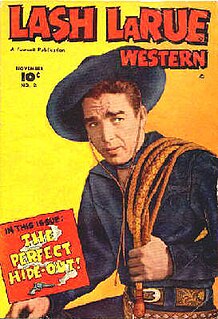
Alfred "Lash" LaRue was a popular western motion picture star of the 1940s and 1950s.
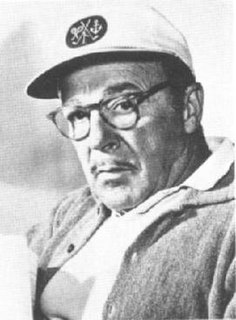
Gordon Douglas Brickner was an American film director and actor, who directed many different genres of films over the course of a five-decade career in motion pictures.
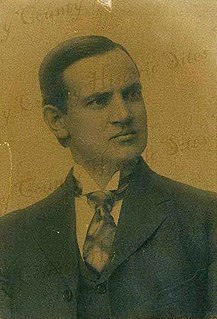
Jesse Edwards "Tim" James was the only surviving son of American outlaw Jesse Woodson James. He was born in Nashville, Tennessee during the height of Jesse James' career as an outlaw. His mother was Zerelda, Jesse James' wife and first cousin.

Mack V. Wright was an American actor and film director. Active as a director from 1920 to the late 1940s, he also had an extensive career as an assistant director, second-unit director and production manager. His heyday was in the 1930s, when he directed or co-directed serials for Republic Pictures and made westerns for Monogram Pictures, often with John Wayne. He was also an actor, appearing in his first film in 1914 and his last in 1934, almost all of them westerns.

Harry Lewis Woods was an American film actor.

Harlem on the Prairie (1937) is a race movie, billed as the first "all-colored" Western musical. The movie reminded audiences that there were black cowboys and corrected a popular Hollywood image of an all-white Old West.

Joseph A. Creaghan was an American film actor. He appeared in more than 300 films between 1916 and 1965, and notably played Ulysses S. Grant nine times between 1939 and 1958, most memorably in Union Pacific and They Died with Their Boots On.

Oklahoma Cyclone is a 1930 American pre-Code Western film directed by John P. McCarthy that is a forerunner of the singing cowboy genre. It stars Bob Steele in his second talking picture playing the title role and singing. The film was released by Tiffany Pictures. The film was remade as Song of the Gringo.

Public Cowboy No. 1 is a 1937 American Western film directed by Joseph Kane and starring Gene Autry, Smiley Burnette, and Ann Rutherford. Based on a story by Bernard McConville, the film is about a singing cowboy who chases down rustlers who are using airplanes, shortwave radios, and refrigerated trucks to steal cattle.
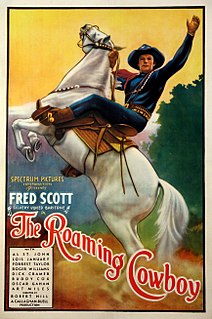
Fred Leedon Scott was an American actor best known as a singing cowboy star in Westerns during the 1930s and 1940s.

Rootin' Tootin' Rhythm is a 1937 American Western film directed by Mack V. Wright and starring Gene Autry, Smiley Burnette, and Armida. Based on a story by Johnston McCulley, the film is about two cowboys who assume the identities of dead outlaws in order to stop a bunch of cattle rustlers, later discovering that the outlaws are far from dead.
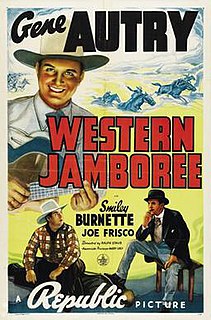
Western Jamboree is a 1938 American Western film directed by Ralph Staub and starring Gene Autry, Smiley Burnette, and Jean Rouverol. Based on a story by Patricia Harper, the film is about a singing cowboy who goes up against a gang of outlaws who are looking to steal the valuable helium gas beneath the cowboy's ranch.
Budd Leland Buster, usually credited as Budd Buster, was an American actor known for B western films. He sometimes was credited as George Selk in his later work.

Bob Baker was a singer who had several starring roles as a singing cowboy in the late 1930s.

Courage of the West was a 1937 "B" movie directed by Joseph H. Lewis in which Bob Baker made his debut as a singing cowboy.
Fleming Allan was an American composer of Western music, who helped make that genre popular in the 1930s.


















